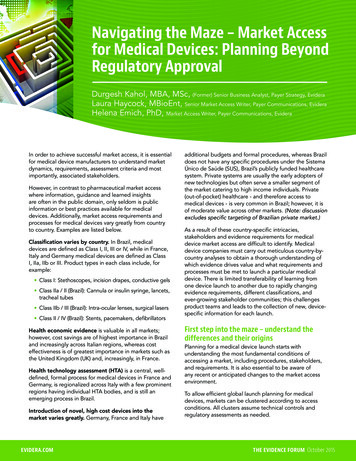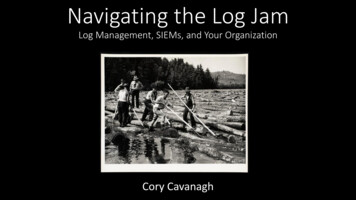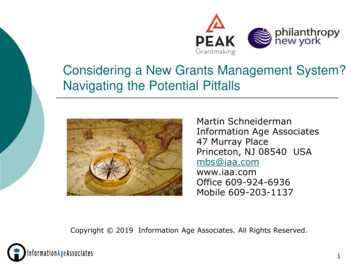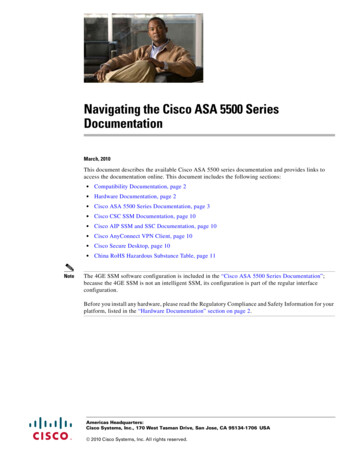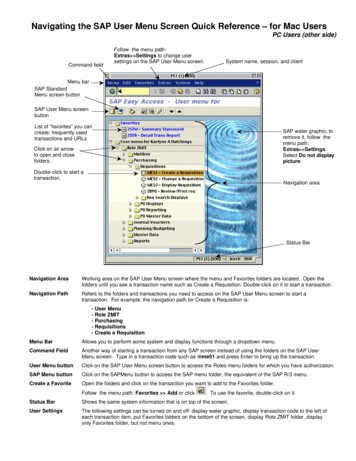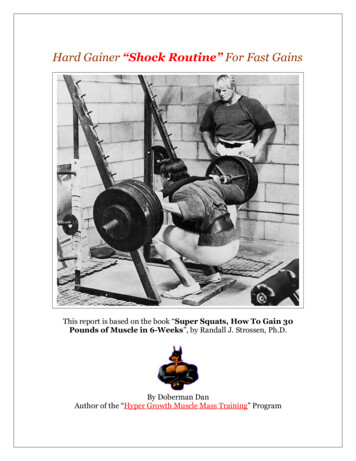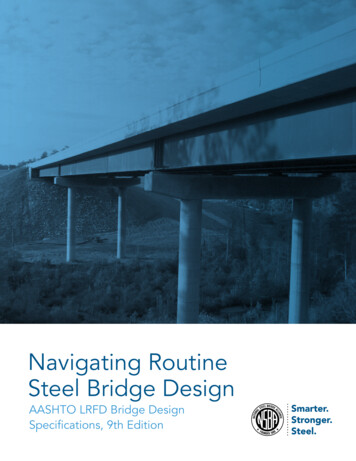
Transcription
Navigating RoutineNavigatingRoutineSteel BridgeDesignAASHTOLRFD BridgeDesignSteelBridgeDesignSpecifications, 9th EditionAASHTO LRFD Bridge DesignSpecifications, 9th Edition
AISC 2021byAmerican Institute of Steel ConstructionAll rights reserved. This book or any part thereof must not be reproducedin any form without the written permission of the publisher.The AISC logo is a registered trademark of AISC.The information presented in this publication has been prepared following recognized principles of designand construction. While it is believed to be accurate, this information should not be used or relied uponfor any specific application without competent professional examination and verification of its accuracy,suitability and applicability by a licensed engineer or architect. The publication of this information is not arepresentation or warranty on the part of the American Institute of Steel Construction, its officers, agents,employees or committee members, or of any other person named herein, that this information is suitablefor any general or particular use, or of freedom from infringement of any patent or patents. All representations or warranties, express or implied, other than as stated above, are specifically disclaimed. Anyonemaking use of the information presented in this publication assumes all liability arising from such use.Caution must be exercised when relying upon standards and guidelines developed by other bodies andincorporated by reference herein since such material may be modified or amended from time to time subsequent to the printing of this edition. The American Institute of Steel Construction bears no responsibilityfor such material other than to refer to it and incorporate it by reference at the time of the initial publicationof this edition.NSBA Guide to Navigating Routine Steel Bridge Design / i
FOREWORDThe design of bridges requires the efforts of engineers educated and experienced in structuraldesign, specifically the unique aspects of bridge design. However, bridge design need not becomplicated or challenging, particularly for the more routine bridges which form a large part ofthe inventory of transportation structures in the United States. In particular, the design of “routinesteel I-girder bridges,” a workhorse structure type, can be relatively simple if the engineer knowswhere to focus their efforts and is provided with guidance on how to streamline the morepredictable, repetitive aspects of the design effort.To this end, the National Steel Bridge Alliance (NSBA), a division of the American Institute ofSteel Construction (AISC) has developed this Guide to Navigating Routine Steel Bridge Design.The goal of this Guide is to help designers navigate the comprehensive design provisions of theAASHTO LRFD Bridge Design Specifications (AASHTO LRFD BDS), identifying just theprovisions that are applicable to the design of routine steel I-girder bridges, explaining how toapply those provisions, recommending practices proven to lead to economical designs, andsuggesting ways to streamline the design effort.This Guide is meant to be used as an interactive reference, rather than as a textbook read fromcover to cover. The general flow of design tasks is outlined, and at any point in the design processthe reader can quickly jump to a detailed Discussion of any particular AASHTO LRFD BDSprovision. Through this process, a bridge engineer will not only find answers to specific questions,but can also increase their familiarity with, and understanding of, the AASHTO LRFD BDS.We would like to gratefully acknowledge the support of Christopher Garrell (NSBA), who steeredthe development of this Guide. Credit is also due to Kaylene Callicoatt (HDR), who helpedassemble and edit this Guide. Finally, we would like to thank the numerous professionals whoprovided invaluable peer review comments during the writing of this Guide, including: Travis Butz(Burgess and Niple), Matt Farrar (Idaho DOT), Jamie Farris (Texas DOT), Karl Frank(Consultant), Christina Freeman (Florida DOT), Dennis Golabek (WSP), John Holt (Modjeskiand Masters), Ted Kniazewycz (Tennessee DOT), Shane Kuhlman (New Mexico DOT), RonnieMedlock (High Steel Structures), Adam Price (Tennessee DOT), Curtis Rockiki (Texas DOT),Kevin Sear (AECOM), Tony Shkurti (HNTB), Jason Stith (Michael Baker International), GregTurco (Texas DOT), Jeffrey Vetter (Idaho DOT), Dayi Wang (Federal Highway Administration),Wagdy Wassef (WSP), and Jaclyn Whelan (AECOM).Michael Grubb (M.A. Grubb & Associates, LLC)Domenic Coletti, Aleksander Nelson, Anthony Ream (HDR)November 2020NSBA Guide to Navigating Routine Steel Bridge Design / ii
Page intentionally left blankNSBA Guide to Navigating Routine Steel Bridge Design / iii
TABLE OF CONTENTSSCOPE OF THIS GUIDE . 1DETERMINATION DEFINITIONS. 3TERMINOLOGY . 4DEFINITION OF A “ROUTINE STEEL I-GIRDER BRIDGE” . 5DEFINITION CHECKLIST FOR A “ROUTINE STEEL I-GIRDER BRIDGE” . 9USEFUL REFERENCES . 11GENERAL FLOW OF DESIGN TASKS . 15GRAPHICAL INDEX OF DESIGN TASKS . 16DESIGN TASK QUICK LINKS . 20General Considerations . 21Deck Design . 22Resistance Factors and Load Modifiers . 23Load Combinations and Load Factors . 24Live Load Force Effects - Introduction . 25Live Load Force Effects - Flexure . 26Live Load Force Effects - Shear . 27Other Load Effects and Factors Affecting Load Effect Calculations . 28Girder Flexure Design – General . 29Girder Flexure Design – Constructibility . 30Girder Flexure Design – Service Limit State . 31Girder Flexure Design – Fatigue and Fracture Limit State . 32Girder Flexure Design – Strength Limit State . 33Girder Shear Design . 34Stiffener Design . 35Shear Connector Design . 36Splice Design. 37Cross-Frame/Diaphragm Design . 38Bolted Connection Design . 39Welded Connection Design . 40Connection Design – Miscellaneous Checks . 41SECTION 1: INTRODUCTION . 42SECTION 2: GENERAL DESIGN AND LOCATION FEATURES . 48SECTION 3: LOADS AND LOAD FACTORS . 53SECTION 4: STRUCTURAL ANALYSIS AND EVALUATION . 82SECTION 6: STEEL STRUCTURES . 118CONCLUSION . 412NSBA Guide to Navigating Routine Steel Bridge Design / iv
SCOPE OF THIS GUIDEThis NSBA Guide to Navigating Routine Steel Bridge Design (this Guide) primarily address thedesign of steel superstructures for “routine steel I-girder bridges.” The intent is to illustrate whichprovisions of the AASHTO LRFD Bridge Design Specifications (AASHTO LRFD BDS) areapplicable to the design of these types of structures, and perhaps more importantly, whichprovisions are not applicable or are perhaps only partially or conditionally applicable or beyondthe scope of superstructure design. In doing so, it is hoped that this Guide will help designers tostreamline the design process, avoid unnecessary or misguided effort, and simplify their approachto the necessary tasks associated with the design of a more routine steel I-girder bridge. Theintended audience includes, but is not limited to, those designers who may be less experiencedwith steel bridge design. This Guide is intended to be used in combination with the AASHTOLRFD BDS and should not be used as a substitute for the AASHTO LRFD BDS itself.The definition of a “routine steel I-girder bridge” is provided below and is intended to encompassa large family of straight steel I-girder bridges with little or no skew, “routine” span lengths, andcommonly used framing layouts and details. To keep the Guide focused, the following items arespecifically excluded from the scope of this Guide: Barrier rail design: Standard details, often mandated by the local Owner-agency, aregenerally used, so design guidance per se is not needed. Deck design: The design of concrete decks for steel I-girder bridges is often governed byOwner-agency policy manuals (e.g., standard designs, pre-calculated design tables, etc.),and so their design is not addressed herein. Substructure and foundation design: The wide variety of types, configurations, materials,and conditions associated with substructure and foundation design make it difficult toprovide a succinct set of guidelines that would be broadly applicable over all parts of theU.S. Bearing design: The variety of types of bearings and the associated variety of local Owneragency or regional bearing design preferences make it difficult to provide a succinct set ofguidelines that would be broadly applicable over all parts of the U.S. For the purposes ofthis Guide, the use of “routine” bearings (as defined under “Definition of a ‘Routine SteelI-Girder Bridge’ below) is assumed.Given these scope limitations, consideration of the Extreme Event limit state, outside of theidentification of the seismic zone for design, is also omitted from this Guide.If a given bridge somehow falls partially outside the limits of the definition of a “routine steel Igirder bridge” or outside the exclusions of this scope, this Guide may still provide value todesigners; in such cases, senior bridge engineers with extensive experience in steel bridge designshould be consulted when determining if and how to apply any of the recommendations providedherein.NSBA Guide to Navigating Routine Steel Bridge Design / 1
Conversely, designers should be cognizant of local Owner-agency policies which may supersedethe recommendations and information presented in this Guide. In such cases senior bridgeengineers with extensive experience in steel bridge design should be consulted when determininghow to apply this Guide in conjunction with Owner-agency policy.Finally, while the scope of this Guide is limited to helping bridge designers understand andcorrectly apply specific provisions of the AASHTO LRFD BDS, it is worthwhile to briefly addressthe broader scope of bridge design. Correctness of structural design – It is of the utmost importance to correctly design abridge with sufficient strength to carry the intended loads without suffering undue distressor structural failure. The safety of the general public who travel on and under bridges is theoverriding concern of a bridge designer. Correctness of geometric information – It is also important that pertinent geometricinformation be correctly, accurately, and precisely calculated and presented on the plans.Errors in the calculation and presentation of geometric information can result in costlydelays, rework, and claims. Correctness of estimated quantities – It is also important that required estimatedquantities, particularly quantities which form the basis of payment for a bridge, becorrectly, accurately, and precisely calculated and presented on the plans. Errors in thecalculation and presentation of estimated quantities can result in costly delays, rework, andclaims.NSBA Guide to Navigating Routine Steel Bridge Design / 2
DETERMINATION DEFINITIONSEach Article of the AASHTO LRFD BDS is assigned a Determination of Applicability to thedesign of routine steel I-girder bridges. These Determinations of Applicability do not relievedesigners of their responsibility to read, understand, and correctly apply the provisions of theAASHTO LRFD BDS, but instead are intended to aid designers in navigating and understandingthose provisions.The various Determinations are defined as follows:1. Applicable: The Article, in its entirety, is fully applicable to the design of routine steel Igirder bridges2. Partially Applicable: Parts of the Article are applicable to the design of routine steel Igirder bridges, other parts are not applicable; see the Discussion for explanation3. Conditionally Applicable: Some or all of the Article may be applicable to the design ofroutine steel I-girder bridges depending on the circumstances; see the Discussion forexplanation4. Not Applicable: None of the Article is applicable to the design of routine steel I-girderbridges5. Beyond Scope of Superstructure Design: Some or all of the Article may be applicableto some aspect of the design of routine steel I-girder bridges, but is not applicable tosuperstructure design; see the Discussion for explanationNSBA Guide to Navigating Routine Steel Bridge Design / 3
TERMINOLOGYFor the purposes of this Guide, the following terminology is defined to avoid confusion:AASHTO LRFD BDS: The term “AASHTO LRFD BDS” refers to the AASHTO LRFD BridgeDesign Specifications, 9th Edition, 2020.Article: The term “Article” (capitalized) refers to a specific numbered Article in the AASHTOLRFD BDS.Commentary: The term “Commentary” (capitalized) refers to a specific numbered commentarysection related to an Article in the AASHTO LRFD BDS.Determination: The term “Determination” (capitalized) refers to the determination ofapplicability of a given Article in the AASHTO LRFD BDS to the design of routine steel I-girderbridges.Discussion: The term “Discussion” (capitalized) refers to the discussion explaining the rationalebehind a specific Determination in this Guide and/or providing guidance on how to streamline thedesign tasks or actions associated with the Article referenced.Guide: The term “Guide” (capitalized) refers to this NSBA Guide to Navigating Routine SteelBridge Design.NSBA Guide to Navigating Routine Steel Bridge Design / 4
DEFINITION OF A “ROUTINE STEEL I-GIRDER BRIDGE”For the purposes of implementing the recommendations of this Guide, a “routine steel I-girderbridge” is defined as the superstructure of a bridge meeting the following characteristics: Straight (non-curved) girders. Straight (non-curved) deck. Framing such that flange lateral bending can be neglected, specifically:o Skew not more than 20 degrees, where skew is measured as the angular deviationof the orientation of the supports from perpendicular to the centerline of the bridge.o Parallel supports or supports which are within 10 degrees of being parallel.o Contiguous cross-frames or diaphragms.o Parallel girders. Constant deck width. Skew Index less than or equal to 0.30, where the Skew Index is as defined in Eq. 4.6.3.3.22. Constant depth girders (i.e., girders with parallel flanges – no haunched or tapered girders). Superstructure designed to meet the live load deflection limits outlined in Article 2.5.2.6.2. Span lengths not exceeding 200 feet. No lateral bracing. Non-hybrid girders (i.e., girder flanges and webs in all spans shall be fabricated using steelof the same grade/yield strength). Steel grades/yield strengths of 36 ksi or 50 ksi. Structural steel using any of the following corrosion protection systems: painted steel,galvanized steel, metallized steel, or uncoated weathering steel. Stringer-type cross-section (no girder-substringer systems), with four or more girders inthe cross-section. No longitudinal web stiffeners. Typical round, headed, stud-type shear connectors.NSBA Guide to Navigating Routine Steel Bridge Design / 5
Cast-in-place concrete composite decks, formed using one of the following methods:o Conventional (removable) wood or steel forms.o Stay-in-place corrugated metal forms.o Partial-depth precast concrete deck panels. Routine barrier rail heights (up to 3’-6” tall.) No sound walls, noise walls, or other solid barriers atop or adjacent to the barrier rails. Bolted field splices. Welded steel bearing stiffeners, intermediate stiffeners, and cross-frame/diaphragmconnection plates. Solid web steel diaphragms (e.g., bent plate, rolled channel shape, rolled I-section, or builtup plate girder diaphragms) bolted to connection plates, or truss-type steel cross-framesbolted or welded to gusset plates or connection plates. Routine bearings, i.e., those types of bearings which do not provide restraint of girder majoraxis bending behavior (bearings which do not restrain girder major axis bending endrotations, do not affect flange stresses, etc.) and thus do not affect the behavior of thesuperstructure in a manner which would invalidate the results of a typical line girderanalysis. Examples of routine bearings include steel-reinforced elastomeric bearing pads,high-load multi-rotational bearings such as disc or pot bearings, or roller and rockerbearings. No cover plates. Generally Seismic Zone 1 only. The guidance provided in this Design Guide may be usefulin the design of bridges in higher seismic zones, with input from a senior bridge engineerwith extensive experience in the design of steel girder bridges for high-seismic zones,particularly when it is appropriate to use a spline model or other simplified analysis methodfor the seismic analysis, such that the need for a seismic analysis model does not imply theneed for a refined analysis model of the steel superstructure. Highway bridges only. Railroad and transit bridges, and bridge intended for use solely bypedestrians, are excluded from the definition of a “routine steel I-girder bridge” for thepurposes of this Guide. However, highway bridges with sidewalk loading are included. Bridges for which the superstructure is not subject to stream flow loading, ice loading, orvessel collision loading. This implies, at a minimum, that there is sufficient freeboardbetween the low chord of the superstructure and the high-water elevation during designflood events. No redistribution of negative moments in continuous beam or girder bridges.NSBA Guide to Navigating Routine Steel Bridge Design / 6
Only single-phase construction or simple multi-phase construction. The definition of“simple multi-phase construction” is as follows: Each phase of construction must meet thevarious definitions of a “routine steel I-girder bridge,” including the requirements foroverall deck and framing plan geometry and minimum number of girders in the crosssections of each phase of construction. In addition, a closure bay and closure pour must beprovided, whereby erection and deck placement of each independent phase ofsuperstructure construction is completed prior to installation of cross-frames or diaphragmsin the closure bay between the adjacent phases of construction, and installation of theclosure bay cross-frames or diaphragms is completed prior to placement of the deck closurepour between the adjacent phases of construction. Note that in addition to evaluating eachphase of construction, the fully-completed bridge must also be evaluated. For furtherguidance, see Section 6.3.2.5.4 of the Reference Manual for NHI Course 130081, Load andResistance Factor Design (LRFD) for Highway Bridge Superstructures. For cases whichdiffer from these conditions, consultation with a senior bridge engineer with extensiveexperience in steel girder bridge design can potentially determine ways to apply some orall of the guidance in this Guide. Only full bridge replacement, new bridge construction, or simple bridge wideningconstruction. The definition of “simple bridge widening” is as follows: Both the existingstructure (including consideration of any partial demolition or partial removal of existingsuperstructure) and the widened portion of the superstructure must meet all otherdefinitions of a “routine steel I-girder bridge,” including the requirements for overall deckand framing plan geometry and minimum number of girders in the cross-sections of boththe existing superstructure and the widened portion of the superstructure. In addition, aclosure bay and closure pour must be provided, whereby erection and deck placement ofeach independent portion of superstructure construction is completed prior to installationof cross-frames or diaphragms in the closure bay between the adjacent portion ofconstruction, and installation of the closure bay cross-frames or diaphragms is completedprior to placement of the deck closure pour between the adjacent portions of construction.Note that in addition to evaluating each stage of construction, the fully-completed bridgemust also be evaluated. For further guidance, see Section 6.3.2.5.4 of the Reference Manualfor NHI Course 130081, Load and Resistance Factor Design (LRFD) for Highway BridgeSuperstructures. For cases which differ from these conditions, consultation with a seniorbridge engineer with extensive experience in steel girder bridge design can potentiallydetermine ways to apply some or all of the guidance in this Guide.These assumptions are intended to limit the scope of the guidance presented in this Guide. Also,by inference many of these assumptions allow for the use of line girder methods of analysis.Refined methods of analysis (such as 2D grid analysis, 2D plate-and-eccentric beam analysis, 3Dfinite element analysis, etc.) are not required, nor recommended, for the design of routine steel Igirder bridges as defined herein. The use of the empirical live load distribution factors associatedwith line girder analysis methods usually result in a slightly, but not excessively, moreconservative live load distribution than would be determined using a refined method of analysis;NSBA Guide to Navigating Routine Steel Bridge Design / 7
nevertheless, refined analysis methods are not required, nor recommended, for the design ofroutine steel I-girder bridges as defined herein.Using refined analysis methods for the design of a routine steel I-girder bridge requires additionaleffort that would be better spent on other tasks such as exploring framing plan and girder designrefinement options, improving plan clarity, or implementing more robust checking and QCprocedures. Refined analysis methods are also inherently more complex than line girder analysismethods, introducing more opportunities for errors. Finally, and importantly, using a refinedmethod of analysis to decrease conservatism in live load distribution could lead a designer toreduce girder flange or web sizes during the initial design of a bridge. This could result indifficulties later when the Owner-agency performs periodic routine load rating analyses of thebridge. For the sake of practicality, most Owner-agencies default to using line girder analysismethods for these load rating analyses – they have hundreds or thousands of bridges to load rateeach year and cannot afford to perform labor-intensive refined analyses when line girder analysismethods would suffice. It is problematic when a bridge exhibits an insufficient load rating duesolely to the minor conservatism of line girder analysis methods, forcing the Owner-agency toinvest limited resources in performing a refined analysis to demonstrate that a bridge has sufficientload-carrying capacity.NSBA Guide to Navigating Routine Steel Bridge Design / 8
DEFINITION CHECKLIST FOR A “ROUTINE STEEL I-GIRDER BRIDGE”Answer all questions with “Yes” or “No”. If any questions are answered “No”, the bridge does notsatisfy the definition of a routine steel I-girder bridge for the purposes of this Guide. For furtherdetail on any of these criteria, please see the preceding section of the Guide: DEFINITION OF A“ROUTINE STEEL I-GIRDER BRIDGE”If a given bridge somehow falls partially outside the limits of the definition of a “routine steel Igirder bridge”, or outside the exclusions of this scope, this Guide may still provide value todesigners; in such cases, senior bridge engineers with extensive experience in steel bridge designshould be consulted when determining if and how to apply any of the recommendations providedherein. Are the girders straight (non-curved)? Is the deck straight? Is the skew not more than 20 degrees? Are all supports parallel (or within 10 degrees of being parallel)? Are the cross-frames contiguous? Are the girders parallel? Is the deck constant width? Is the Skew Index (Eq. 4.6.3.3.2-2) less than or equal to 0.30? Do the girders have a constant web depth? Is the superstructure designed to meet the live-load deflection limits outlined in Article2.5.2.6.2? Are all spans less than 200 feet? Does the design not include the use of lateral bracing? Are all girder flanges and webs fabricated using steel of the same grade/yield strength? Is the steel grade/yield strength of the girders 36 ksi or 50 ksi? Will one of the following corrosion protection systems – painted steel, galvanized steel,metallized steel, or uncoated weathering steel – be used? Does the bridge feature a stringer-type configuration, with four or more girders in the crosssection? Are the girders to be designed without the use of longitudinal web stiffeners? Are typical round, headed, stud-type shear connectors to be used?NSBA Guide to Navigating Routine Steel Bridge Design / 9
Will a cast-in-place composite concrete deck, formed using one of the following methods– conventional (removable) wood or steel forms, stay-in-place corrugated metal forms,partial-depth precast concrete deck panels – be used? Will the bridge be provided with routine barrier rail heights (no more than 3’-6” tall)? Will the bridge be free of superstructure-mounted sound walls, noise walls, or other solidbarriers atop or adjacent to the barrier rails? Will any needed field splices be constructed using bolted connections? Will any bearing stiffeners, intermediate stiffeners, and/or cross-frame or diaphragmconnection plates be fabricated from welded steel plates or bar stock? Will either solid web steel diaphragms (e.g., bent plate, rolled channel shape, rolled Isection, or built-up plate girder diaphragms) bolted to connection plates, or truss-type steelcross-frames bolted or welded to gusset plates or connection plates, be used to brace thegirders? Will only routine bearing types be used? Will the bridge girders be free of cover plates? Is the bridge located in Seismic Zone 1? Is the bridge carrying only highway vehicular traffic? Is the superstructure not subject to stream flow loading, ice loading, and vessel collisionloading? Will the use of design methods involving the redistribution of negative moments incontinuous beam or girder bridges be avoided? Will the bridge be constructed using only single-phase construction or simple multi-phaseconstruction? Will the construction of the bridge fall into one of these three categories – full bridgereplacement, new bridge construction, or simple bridge widening construction?NSBA Guide to Navigating Routine Steel Bridge Design / 10
USEFUL REFERENCESA list of useful references is provided below. These references are frequently cited in the Guide.Some of the references may be slightly dated but represent the best guidance available at the timeof writing of this Guide. In general, the reader can typically compensate for the dated nature ofany particular reference by recognizing where references to specific provisions of the AASHTOLRFD BDS may be out of date; in such cases the current provisions of the AAHTO LRFD BDSshould be followed and the guidance provided in the reference should be interpreted accordingly. AASHTO’s AASHTO Guide Specifications for Wind Loads on Bridges During Construction:At the time of the writing of this Guide, the 1st Edition of this guide specification had beenpublished by AASHTO in 2017
NSBA Guide to Navigating Routine Steel Bridge Design / 2 Conversely, designers should be cognizant of local Owner-agency policies which may supersede the recommendations and information presented in this Guide. In such cases senior bridge engineers with extensive experience in steel br

